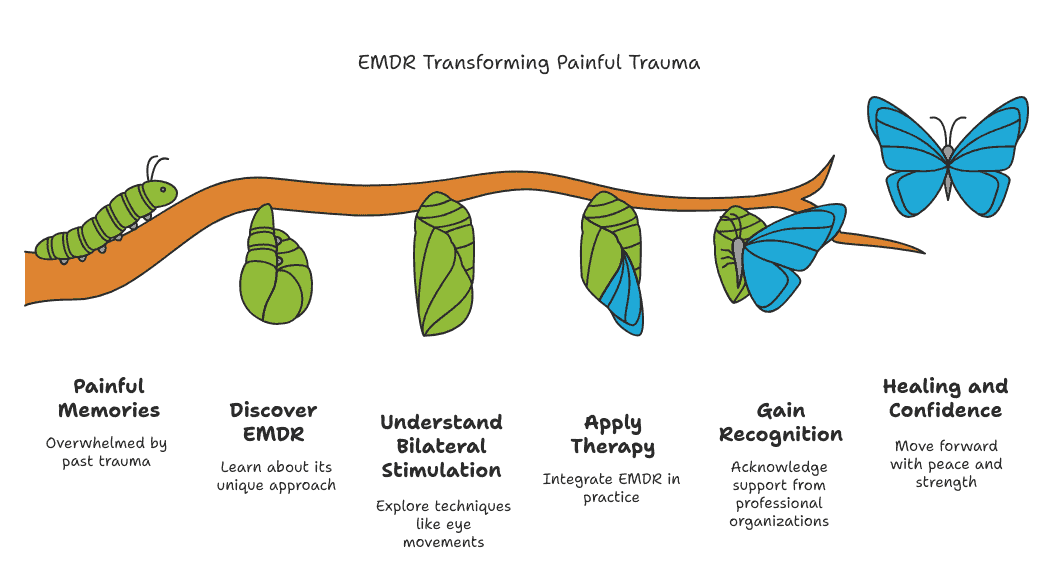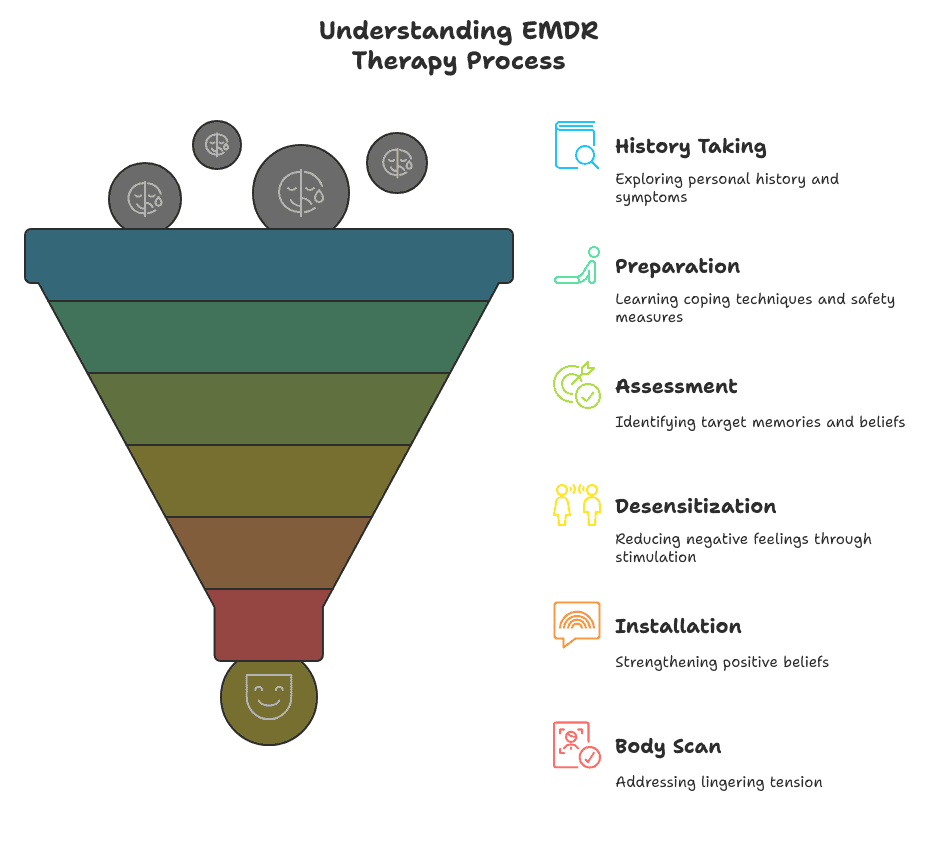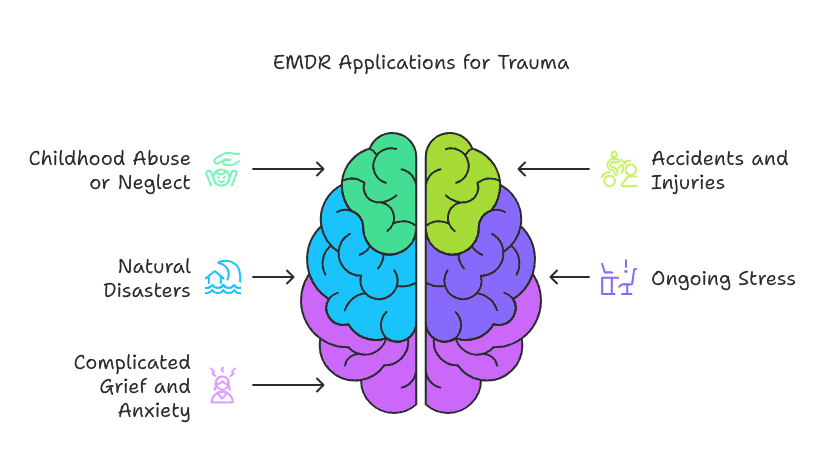
Hello, I’m Gloria Segovia from AERCS Therapy. In this post, I explore how EMDR therapy can offer a powerful way forward for individuals grappling with traumatic experiences.
Here at AERCS, our goal is to make quality care accessible—whether you prefer online sessions or wish to visit us in person. If you’re seeking EMDR therapy, trauma-informed care, or additional support, our experienced team is committed to providing compassionate, professional guidance. Let’s find the right path to promote your mental well-being, together.
Understanding EMDR Therapy: A Path to Healing Trauma.
Trauma can take many forms and can result from events like accidents, abuse, violence, or even prolonged stress. For many Canadians, the aftermath of these events can affect day-to-day life, leading to feelings of anxiety, distress, or a persistent sense of being “on edge.”
Whether you’re dealing with a single traumatic incident or multiple painful experiences, it is important to recognise that help is available and that recovery is possible.
My aim with this post is to introduce a specific therapeutic approach known as Eye Movement Desensitization and Reprocessing (EMDR). EMDR has shown effectiveness in helping people process distressing memories, manage overwhelming emotions, and regain a sense of control. By understanding how EMDR works and why it may be beneficial, you can make a more informed decision about seeking therapy as part of your healing journey.
At AERCS, we strive to provide empathetic and evidence-based support for those who have experienced trauma. I established AERCS with a commitment to helping individuals build resilience and reclaim their lives after difficult events. With a Bachelor of Social Work (BSW) Honours and a Master’s Degree in Social Work (MSW), I’ve further expanded my expertise by completing training in EMDR through EMDR Professional Training, an EMDRIA-approved provider responsible for ensuring top-tier EMDR instruction.
Under my guidance, the AERCS team is dedicated to offering a safe, understanding, and welcoming environment where you can explore EMDR therapy as a path to healing.

What is EMDR Therapy?
When I first discovered Eye Movement Desensitization and Reprocessing (EMDR) therapy, I was immediately drawn to its unique approach in helping individuals process painful memories.
EMDR was originally developed in the late 1980s by psychologist Dr. Francine Shapiro, who noticed that certain eye movements seemed to lessen the intensity of distressing thoughts.
Over time, she refined this discovery into a structured therapy that uses bilateral stimulation—such as guided eye movements, tapping, or auditory tones—to help the brain work through traumatic experiences more effectively.
In my practice as a registered psychotherapist in Ontario, I see EMDR as much more than just a technique; it is a way to offer hope and relief to those who have felt stuck or overwhelmed by the weight of their past.
Since its inception, EMDR has gained recognition from numerous professional organisations, including the World Health Organization (WHO), the Canadian Psychological Association, Ontario Psychological Association, and the Canadian Mental Health Association (CMHA).
Its growing acceptance in the mental health field reflects what I have witnessed time and time again: EMDR can be a profound catalyst for change, allowing you to transform your relationship with painful memories and move forward with greater confidence and peace.
Core Principles of EMDR.
At the heart of EMDR therapy is the understanding that our brains have a natural ability to heal from psychological trauma, much like our bodies heal from physical wounds. When an event overwhelms us—such as an accident, abuse, or prolonged stress—the memory of that event can remain “frozen” or improperly stored, leading to distressing symptoms and emotional pain.
The primary mechanism that makes EMDR unique is bilateral stimulation, which may involve guided eye movements, gentle tapping, or auditory cues. Through this process, the brain is encouraged to revisit and reprocess traumatic memories in a more adaptive way.
Instead of reliving the same painful experiences, EMDR guides you towards reframing them, ultimately reducing the intensity of the negative emotions attached to those memories.
From my perspective, the core principle of EMDR therapy is to activate your natural resilience, giving you the space to process your experiences without becoming overwhelmed.
By combining focused attention on a painful memory with bilateral stimulation, the therapy helps move stuck or fragmented memories into a healthier, more integrated place in the mind.
This is how EMDR supports a deeper sense of healing and emotional freedom—one that I’ve seen empower many of my clients to rediscover hope and well-being.
Why EMDR is Unique.
What truly sets EMDR therapy apart, in my experience, is its focus on how traumatic memories are stored in the brain rather than on repeatedly talking through the traumatic event.
Traditional talk therapies can sometimes feel overwhelming because you may have to relive the details of your experience again and again.
EMDR, however, uses bilateral stimulation—such as eye movements, tapping, or auditory tones—to help your brain reprocess these disturbing memories in a more adaptive way.
In practice, this means we do not have to stay stuck in the distressing emotions or relive the pain extensively.
Instead, we gently guide you through a structured process that allows your brain to heal naturally, similar to how a physical wound mends under the right conditions.
By addressing how memories are stored, EMDR works at a deeper level, giving you the chance to move forward without the weight of unresolved trauma.
This efficient, targeted method of therapy is one of the reasons I’ve chosen to incorporate EMDR into my work—because I have seen firsthand how it can provide a genuine sense of relief and renewed hope for individuals seeking a path to recovery.
How Does EMDR Work?
The Eight Phases of EMDR.
In my practice, I find that the eight-phase structure of EMDR therapy provides a clear roadmap for healing. Each phase is designed to ensure your safety, build your understanding of the process, and gradually address the traumatic memories that may be holding you back. Here is a brief overview of what you can expect:
- History Taking and Treatment Planning:
In this initial phase, I work with you to explore your personal history and identify the memories or experiences that feel most distressing. We will discuss your current symptoms and any life events that may contribute to these feelings. Together, we develop a plan tailored to your unique needs, outlining which memories we will target first and how we will approach the process. - Preparation:
Before we begin actual reprocessing, I take the time to explain how EMDR works and what you can expect during sessions. You will learn a variety of coping and grounding techniques, such as deep breathing or visualisation exercises, to help you manage any distressing feelings that may arise. My goal is to ensure you feel safe, informed, and ready to begin the deeper work of EMDR. - Assessment:
In the assessment phase, we identify the specific target memory, along with the negative beliefs or emotions tied to it. I will help you pinpoint how you feel in your body when you think about this memory, as well as what you would prefer to believe about yourself instead. This clarity sets the stage for effective reprocessing. - Desensitization:
This is where the bilateral stimulation (eye movements, tapping, or auditory tones) comes into play. As you focus on the target memory, I guide you through a series of bilateral stimulation sets. During this process, the intensity of your negative feelings often begins to diminish. You may find new insights or memories surface, all of which we will process as they arise. - Installation:
Once the distress around the original memory decreases, we work to “install” or strengthen a positive belief about yourself. This might be something like “I am strong” or “I can protect myself.” Through further bilateral stimulation, we help this positive statement feel more genuine and deeply rooted. - Body Scan:
Next, I guide you to scan your body for any lingering tension or discomfort related to the memory. If any unsettling sensations remain, we address them with additional bilateral stimulation until you can recall the memory without experiencing significant physical or emotional distress. - Closure:
At the end of each session, whether we have fully processed the memory or need to continue in the next session, I ensure you leave feeling stable and supported. We revisit the grounding techniques and strategies learned in the preparation phase to help you manage any residual emotions before our next session. - Re-evaluation:
In our following session, we assess how the memory feels to you now and whether you’ve experienced any changes in thoughts, emotions, or physical sensations. We decide if more work is needed on the same memory or if we are ready to move on to a new target. This re-evaluation phase ensures that you continue making steady progress towards relief and healing.
By following these eight phases in a structured and supportive environment, we can gradually work through distressing memories and help you move towards a place of greater peace and well-being.

The Role of the Therapist.
As your therapist, my priority is to guide you through EMDR in a way that feels both safe and empowering. From the very start, I take time to build a trusting relationship by listening to your story, validating your experiences, and understanding the challenges you face.
Rather than rushing into reprocessing traumatic memories, we work together to establish a strong foundation—this may involve learning relaxation strategies, discussing your goals for therapy, or simply exploring how you feel about the process.
During EMDR sessions, I carefully monitor your emotional and physical responses, adjusting the pace as needed to ensure you do not become overwhelmed.
In each phase, I provide clear directions and supportive feedback, helping you identify negative beliefs and replace them with healthier, more adaptive ones. Additionally, I am there to help you interpret any insights or emotions that may arise during bilateral stimulation, always respecting your comfort level and boundaries.
Above all, my role is to create a nurturing, non-judgemental environment where you can safely work through unresolved trauma. By combining my professional training with genuine compassion, I aim to help you gain new perspectives on past experiences and move towards greater emotional freedom.
Through each step of EMDR therapy, you can count on me to stay by your side, celebrating every milestone on your journey to healing.
Typical Session Structure.
During our work together, an EMDR therapy session generally lasts about 85 minutes. I find this length allows us enough time to check in on your current emotional state, engage in the reprocessing work, and then wind down properly before concluding the session. While each appointment may vary slightly, here is a general structure you can expect:
- Check-In:
I begin by asking how you are doing—both emotionally and physically. We review any significant events or feelings that arose since our last session, and I answer any questions you might have. This time helps us determine the specific goals or targets we want to address during the session. - Reprocessing Phase:
Once we have a clear plan, we move into the EMDR protocol. This involves identifying a target memory or emotion and engaging in bilateral stimulation (such as eye movements, tapping, or auditory cues). As we proceed, I will guide you through any thoughts, feelings, or bodily sensations that emerge, ensuring you remain within a safe and manageable window of comfort. - Brief Checkpoint:
After a few sets of bilateral stimulation, we pause briefly to evaluate how you are feeling and whether any new insights have emerged. This ongoing feedback loop allows me to adjust the pace or focus as needed, keeping the process aligned with your emotional capacity. - Installation of Positive Beliefs:
As the intensity of your distressing memory decreases, we work to “install” more empowering, adaptive beliefs. These positive statements help reinforce a healthier emotional framework, paving the way for lasting change. - Closure:
Before our session ends, I lead you through calming or grounding techniques to help you leave feeling secure. If there is more work to be done on the same target, we note where we left off and create a plan for our next session. I’ll also encourage you to practise any techniques at home that can support continued healing between appointments.
By following this general structure, we can ensure each session moves you closer to your goals while also maintaining a sense of safety and stability.
Through careful pacing and ongoing communication, EMDR therapy can become a powerful tool for transforming how you relate to challenging or traumatic experiences.

Benefits of EMDR Therapy.
Evidence-Based Approach.
One of the most encouraging aspects of EMDR therapy is its strong foundation in scientific research. Over the years, numerous studies have highlighted how EMDR can effectively reduce the impact of traumatic memories, anxiety, and other mental health challenges. In fact, one particular study published in the Psychology and Behavioral Science International Journal showed some remarkable findings:
- Over 80% of participants experienced a significant reduction in symptoms of PTSD, anxiety, and depression after EMDR therapy.
- Before therapy, many reported high stress levels—often an 8 or 9 out of 10, indicating severe distress.
- After EMDR sessions, these ratings dropped to around 2 or 3 out of 10, signifying a substantial decrease in emotional intensity.
- Many individuals began to feel noticeable relief after just one session, with continued improvement over multiple sessions.
Source: Pérez M C, Estévez M E, Becker Y, Osorio A, Jarero I, et al. Multisite Randomized Controlled Trial on the Provision of the EMDR Integrative Group Treatment Protocol for Ongoing Traumatic Stress Remote to Healthcare Professionals Working in Hospitals During the Covid-19 Pandemic. Psychol Behav Sci Int J .2020; 15(4): 555920. DOI::10.19080/PBSIJ.2019.10.555920.
These statistics align with what I have seen in my own practice: while every person’s healing process is unique, EMDR often leads to tangible, lasting changes in how individuals think and feel about past traumatic events.
By directly targeting how distressing memories are stored in the brain, EMDR helps people move beyond the cycle of simply “managing” their symptoms—allowing them to experience genuine transformation and a renewed sense of hope.
Targeting Core Trauma.
One of the reasons I find EMDR therapy so powerful is its direct focus on the core traumatic memories rather than just the surface-level symptoms.
In many traditional therapies, clients may find themselves talking about their experiences repeatedly without ever feeling a genuine release from the pain.
EMDR, however, targets the way these memories are held in the brain, aiming to help you fully process and integrate them in a healthier way.
By addressing the root cause of your distress, EMDR often leads to deeper, more enduring results. Instead of continually reliving the same feelings of fear, guilt, or shame, you can gradually replace them with a sense of safety, empowerment, and self-compassion.
In my practice, I have seen how this shift can ripple out into all areas of life—improving relationships, increasing self-esteem, and allowing for a renewed sense of confidence moving forward.
When you free yourself from the unresolved core traumas, you are much better positioned to experience genuine healing and growth.
Reduced Therapy Time.
Another advantage of EMDR therapy is that it can often bring about meaningful relief in fewer sessions than some other therapeutic approaches.
Because EMDR works by directly reprocessing the way traumatic memories are stored, clients frequently notice a reduction in emotional intensity fairly quickly.
In my experience, many individuals begin to see shifts in how they feel and think about a specific memory after just a few sessions.
Of course, the exact number of sessions needed can vary based on the complexity of the trauma and each person’s unique healing process.
Some people benefit from a short, focused course of EMDR, while others may need more time to address multiple or deeply rooted issues. Nevertheless, the goal remains the same: to break free from the lingering effects of trauma and move toward a life that is no longer defined by distressing memories.
By cutting through the layers of emotional pain more efficiently, EMDR can help pave the way for faster, more enduring results.
Overall Emotional Well-Being.
Beyond reducing the immediate distress linked to traumatic memories, EMDR therapy can also have a positive ripple effect on many areas of daily life.
When you’re no longer weighed down by unresolved trauma, it often becomes easier to navigate relationships, make decisions, and engage in activities that bring you joy. Many people describe feeling a renewed sense of purpose, improved self-esteem, and greater clarity about what they want for their future.
From my perspective, EMDR fosters this wider emotional well-being by giving you the space to reframe how you see yourself and your past.
Rather than feeling defined by what happened, you can learn to build on your strengths and cultivate healthy coping strategies.
Over time, this holistic transformation contributes to better mental health and a deeper sense of peace—ultimately helping you live a life that’s less about merely surviving, and more about truly thriving.
Is EMDR Right for You?
Types of Trauma EMDR Can Help.
In my work, I have seen EMDR therapy make a meaningful difference for individuals facing a wide range of traumatic experiences. While it is often associated with Post-Traumatic Stress Disorder (PTSD), the applications go well beyond that diagnosis. Here are some examples of the types of trauma EMDR can help address:
- Childhood Abuse or Neglect: Unresolved issues from early life can significantly impact relationships, self-esteem, and day-to-day functioning. EMDR can help reprocess these formative memories so they hold less emotional charge.
- Accidents and Injuries: Whether it’s a car collision, workplace incident, or a sports-related injury, trauma can remain long after physical wounds have healed. EMDR can support the emotional recovery process.
- Natural Disasters: Events like floods, wildfires, or other large-scale emergencies can leave deep psychological scars. Through EMDR, it’s possible to lessen the lingering anxiety associated with these unpredictable experiences.
- Ongoing Stress or “Lesser-Known” Traumas: Sometimes, the accumulation of smaller, repetitive stressors—such as an unhealthy work environment or chronic relationship issues—can lead to significant emotional difficulties. EMDR helps in reframing these stressors in a more manageable way.
- Complicated Grief and Anxiety: Grief that doesn’t follow a typical pattern, or anxiety that feels unmanageable, may also be rooted in traumatic experiences. EMDR works to uncover and resolve the underlying triggers, offering relief that can be both profound and enduring.
It’s important to remember that trauma is not strictly defined by any single event. If something is causing you intense distress, interfering with your daily life, or preventing you from moving forward, it may be worth exploring EMDR therapy.
From my perspective, this approach can be incredibly versatile—tailored to fit your unique experiences and guide you toward a healthier, more peaceful state of mind.

Potential Limitations or Risks.
While EMDR therapy can be incredibly effective, it is important to acknowledge that no single approach is suitable for everyone.
One of the primary challenges is that the reprocessing of traumatic memories can temporarily heighten emotional distress. You may experience strong emotions, vivid memories, or even physical sensations during or between sessions.
If you have had chronic trauma or a history of self-harm, it may be necessary to spend more time building up coping skills and emotional stability before delving into the deeper layers of EMDR.
It is also crucial to work with a qualified EMDR therapist who has undergone the proper training, including an approved EMDRIA certification process.
Having a professional who understands the complexities of trauma can help ensure you receive the right level of support at each stage of therapy.
By openly discussing any concerns or mental health conditions you have—such as active substance use issues or unmanaged severe mental illness—we can make sure EMDR is introduced at the appropriate time and in the most supportive environment.
If you are unsure whether EMDR is the right fit for you, a thorough assessment and honest dialogue can help determine the best path forward.
In some cases, we may combine EMDR with other therapy models or recommend an alternative approach if that will better serve your unique needs. The goal is always to ensure your well-being is at the forefront of any therapeutic plan.
EMDR at AERCS: Our Approach.
Integrated Care Model.
At AERCS, I believe in offering a truly integrated care model that addresses the multifaceted nature of trauma. While EMDR therapy is a central part of our approach, we also provide a wide range of services—including trauma-informed therapy, individual counselling, addiction counselling, emotional regulation, anger management therapy, play therapy for children, and anxiety therapy.
By weaving together these complementary modalities, I aim to create a comprehensive support system that meets you where you are, no matter the complexity of your experiences.
In practical terms, this means our work together could involve blending EMDR with other types of therapy if that proves beneficial.
For example, we might start with individual counselling sessions to help build emotional resilience before introducing EMDR, or we could combine EMDR with anger management techniques to target specific triggers that are rooted in past trauma.
My ultimate goal is to ensure you have access to the right combination of therapeutic tools to promote genuine, lasting healing. This holistic, person-centred philosophy allows us to tailor your care plan in a way that feels both supportive and empowering—so you can move forward with greater confidence and clarity.
Safe and Supportive Environment.
At AERCS, creating a safe and supportive environment is at the core of everything we do. Whether you choose to visit us in Toronto or Orangeville, or prefer the convenience of online counselling sessions, we strive to ensure you feel welcome and respected from the moment you reach out.
I firmly believe that genuine healing begins with feeling understood and secure, which is why every aspect of our practice—from our comfortable offices to our flexible appointment options—is designed to prioritise your comfort and well-being.
We embrace individuals from all walks of life, understanding that everyone’s journey is unique.
As a result, our therapeutic space is non-judgemental and inclusive, recognising the importance of cultural sensitivity and personal identity.
My team and I are here to listen, guide, and support you at every step of your healing process, ensuring that you can engage in EMDR therapy (and any of our other services) with a sense of trust and emotional safety.
By focusing on empathy, confidentiality, and compassion, we aim to foster an environment where you can openly explore your trauma and move forward with confidence.
Trauma-Informed Practice.
My team and I at AERCS use a trauma-informed practice approach, which means we recognise the broad impact trauma can have on your emotional, physical, and mental well-being.
Rather than focusing solely on symptoms, we look at how your past experiences might shape your current responses and relationships. This understanding informs every aspect of our work, from the initial assessment to the therapeutic techniques we use.
By integrating trauma-informed principles—such as safety, choice, collaboration, trustworthiness, and empowerment—we strive to minimise re-traumatisation.
For instance, we encourage open communication, so you feel comfortable expressing any concerns or boundaries you may have during EMDR therapy or other forms of counselling. This way, we can tailor the therapeutic process to your needs and ensure you remain in control of your healing journey.
Ultimately, our goal is to create a supportive atmosphere where you can process difficult memories with confidence and compassion, fostering enduring growth and resilience.
What to Expect in Your First EMDR Session.
Initial Consultation.
When you first reach out to me at AERCS, I will begin by arranging an initial consultation. As mentioned above, this conversation can take place in person at our Toronto or Orangeville office, or via an online appointment—whichever option you find most comfortable.
During this session, we will discuss your primary concerns, your personal goals, and any past or current challenges you may be facing.
I will also explain the EMDR therapy process in more detail, answering any questions you might have and addressing any anxieties about starting a new form of treatment.
I see this first consultation as an opportunity for both of us to determine whether EMDR—along with other services at AERCS—aligns well with your needs.
At the same time, it allows me to develop a preliminary sense of your background, emotional state, and unique situation. From there, we can begin to create a tailored plan for your healing journey, ensuring that you feel informed and at ease as we move into the next stages of therapy.
Treatment Goals and Planning.
Once we’ve completed our initial consultation, I will work with you to clarify your treatment goals and develop a personalised plan. This phase typically includes identifying which traumatic memories or areas of distress feel most urgent to address.
Together, we will map out a strategy that best supports your well-being, considering factors such as the nature of your trauma, your current life situation, and any other forms of therapy or support you may be receiving.
I believe in a collaborative approach, so your input is essential at every step. You know yourself best, and your voice will guide how we prioritise our focus in EMDR therapy.
We will also discuss an approximate timeline and the overall structure of the therapy, including the number of sessions we might schedule and the techniques that could be most helpful for your specific needs.
My goal is to ensure you feel comfortable, informed, and confident in the plan we create, setting a clear path towards healing and recovery.
Practicalities.
An EMDR therapy session at AERCS typically lasts 85 minutes—allowing enough time to check in, work through reprocessing, and conclude on a stable note.
You can choose to meet at either our Toronto or Orangeville location, or opt for the online therapy option if that works better for your schedule and comfort level.
To book your EMDR session, simply visit our appointment page or complete the easy form at the bottom of this blog post, and we’ll work with you to find a convenient time.
The goal is to make getting started as straightforward as possible, so that you can focus on what truly matters—moving towards healing and well-being.
Self-Care Tips During EMDR Therapy.
Managing Emotional Responses.
During EMDR sessions, it is natural to experience a range of emotions—sometimes intensely.
One way to navigate these feelings is by practising grounding techniques, such as deep breathing, progressive muscle relaxation, or guided visualisation.
These strategies help you stay connected to the present moment rather than becoming overwhelmed by past memories.
I often encourage my clients to journal after a session, noting any new insights or lingering emotions. This act of writing things down can help organise your thoughts and reduce the intensity of distress.
If you ever find yourself struggling to cope between sessions, reaching out to me is always a valid step towards feeling more supported.
Building a Support Network.
Healing from trauma does not happen in isolation. While you are your own greatest advocate, having a support network can significantly reinforce the progress you make in EMDR therapy.
This network may include close friends, family members, or community groups—anyone you trust to provide encouragement and a listening ear.
If sharing details of your therapy feels too private, it can still be comforting to let loved ones know that you are going through an emotional process and may need extra understanding.
Sometimes, simply knowing you are not alone on this journey can offer a powerful sense of comfort and validation.
Practical Lifestyle Adjustments.
It is important to remember that EMDR is just one piece of the overall puzzle of well-being.
Making practical lifestyle adjustments can further support your mental health and resilience.
For instance, regular exercise—such as walking, yoga, or biking—can help release built-up tension and reduce stress.
Paying attention to your eating habits, hydration levels, and sleep patterns can also boost your emotional stability and energy levels.
Finally, consider scheduling downtime around your EMDR sessions. Since these sessions can be intense, setting aside time to relax or engage in uplifting activities—like reading, nature walks, or listening to soothing music—helps you process your experiences in a more balanced, restorative way.
Understanding EMDR Therapy: Call to Action.
A Recap of Key Points.
As we have explored, EMDR therapy can be a profound way to address the lingering effects of trauma.
It focuses on how memories are stored in the brain, targeting the core issues rather than just the surface-level symptoms.
By following a structured eight-phase approach, EMDR enables you to process distressing events more adaptively and, ultimately, achieve greater emotional freedom.
We have also discussed key benefits, including reduced therapy time, a focus on core trauma, and the potential for significant improvements in overall well-being.
Encouragement and Reassurance.
I understand that taking the first step toward healing can feel overwhelming. However, remember that you do not have to face this journey alone.
Whether you have experienced a single traumatic event or multiple stressors over time, there is hope and help available.
With a solid therapeutic partnership and the right resources, you can begin to release the weight of your past and embrace a more fulfilling future.
Reach Out & Move Forward.
If you feel ready to explore EMDR therapy or want to learn more about the services at AERCS, I encourage you to take that next step.
You can easily book an appointment online by visiting our appointment page or filling out the form below.
You can also reach us by phone at 416-486-1171 (Toronto) or 519-938-9191 (Orangeville).
Whether you choose to connect online, by phone, or through the simple form at the bottom of this blog post, please know that we are here to support you on your journey to healing and well-being.

Take the First Step Toward Healing Today
Discover the transformative power of EMDR therapy with Gloria, an experienced and compassionate psychotherapist dedicated to helping you process trauma, reduce anxiety, and reclaim your life.
Fill out the form below to connect directly with Gloria and start your journey toward peace and clarity. Your healing begins here. Don’t wait—complete the form now!
Do You Need EMDR Therapy?
Take this quick quiz to see if EMDR therapy at AERCS could benefit you!











